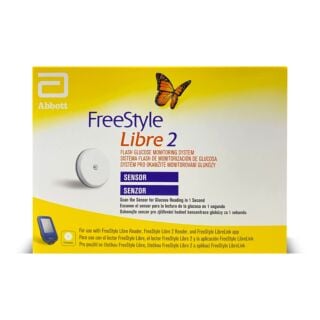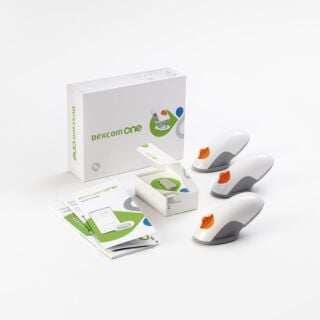7 major differences between flash and continuous glucose monitoring (CGM)

What is the difference between flash glucose monitoring and CGM?
As the name suggests, a continuous glucose monitor automatically monitors your blood glucose levels continuously throughout the day without needing to do anything, and sends results to a smartphone every few minutes, whereas, flash glucose monitors only check glucose levels when you scan the device.
Why might you need to monitor your blood glucose levels?
Blood glucose monitoring is an essential part of managing type 1 and some cases of type 2 diabetes. This condition causes blood sugar levels to become dangerously high or low if it’s not controlled.
Modern devices allow you to check these levels in real-time without the need to finger prick and draw blood. People with diabetes work with their healthcare provider on a plan to keep their diabetes under control, and they may recommend glucose monitoring at various times throughout the day. This is particularly important for those with type 1 diabetes which cannot be controlled by lifestyle changes, as it is caused by the body’s inability to produce enough insulin, a hormone that controls glucose levels in the blood.
The important times to monitor blood sugar levels are before and after eating, sleeping and exercising, and with modern glucose monitoring devices, it’s much quicker, easier, and painless to monitor more frequently.
The two main ways of tracking your blood sugar levels are via flash glucose monitoring and continuous glucose monitoring (CGM). In this guide, we’ll help explain what they do, how they are different and which is the most suitable for you.
What is flash glucose monitoring?

You may see some people wearing a small white sensor shaped like a disc on the back of their upper arm, this is a flash glucose monitor. It’s worn at all times, even in the bath or shower, and is replaced as and when the manufacturer states (usually every 14 days). The sensor is scanned with a reader and gives you instant results of where your glucose levels are at that time, and it can send the results to your mobile app and to your clinician if necessary.
This type of monitoring means you can share glucose information with your healthcare team virtually and instantly, and spot trends in your glucose levels such as when they rise and fall.
Flash glucose monitoring is often called its brand name ‘Freestyle Libre’, read our guide to find out more about this particular model of flash, the Freestyle Libre 2.
What is CGM?

CGM or continuous glucose monitoring is a sensor device that can be worn on various parts of the body, not just the arm. CGM keeps reading your glucose levels and sends the results to your smartphone every few minutes without needing to scan the sensor. Keeping track of your blood sugar levels with a CGM is more automatic than a flash and it can alert you when your blood sugar gets too low or too high.
Both types of glucose monitoring systems work by measuring the amount of glucose in the fluid just under the skin known as interstitial fluid.
What is the difference between flash glucose monitoring and CGM?
Flash and CGM have lots of similarities, they’re both regularly used methods of managing diabetes through a sensor device providing real-time glucose readings that can be shared with your clinician and help prevent adverse diabetic events.
So how do you know which one to use? Here are the 7 major differences between the two glucose monitoring systems that may help you determine what is the most suitable for you.
-
1. Automatic vs manual scanning
With a condition such as diabetes, managing it with minimal effort and disruption to normal life is important and a big consideration, but this can be out of your control and is all dependent on the type of diabetes that you have. However, automatic scanning which CGM requires minimal effort as it automatically monitors your blood sugar and produces a reading.
Flash on the other hand is more manual, you need to scan the sensor on your arm with a reader in order to get results.
-
2. Compatibility with insulin pumps
Some people with diabetes use an insulin pump which is attached to the body and its purpose is to deliver small amounts of insulin to your body throughout the day and night rather than injecting insulin yourself. Insulin pumps are a more flexible and tailored way of delivering insulin and keeping your blood glucose levels in your target range. Although you’ll still need to inject insulin, it will be less often with an insulin pump.
If you have an insulin pump, your glucose monitor needs to be compatible with this. Continuous glucose monitors are compatible with an insulin pump and can actually alter your dose of insulin based on your blood glucose levels which are being monitored at all times by the CGM. Your glucose monitor working with your insulin pump is known as a ‘closed loop system’.
This is yet another way of making diabetes management more flexible and accurate and giving patients peace of mind.
-
3. Availability on the NHS
Cost is a big factor in deciding between a flash glucose monitor and a CGM. Some people with diabetes may qualify for a free flash or CGM on the NHS depending on where they live. Eligibility varies across the UK.
The general consensus is that anyone with type 1 diabetes is eligible for a free glucose monitor, the type of monitor depends on where you live. In England and Wales, this is likely to be a CGM and in Scotland, a flash glucose monitor is usually offered. If you live in Northern Ireland you will need to check your eligibility with your healthcare team.
Alternatively, if you aren’t eligible but would still benefit from managing your diabetes in this way, you can purchase a CGM or flash from a pharmacy in-store or online.
-
4. Cost
Freestyle Libre is the only flash glucose monitor available to buy and our cost starts from £49.99 depending on the model. This will need to be replaced every 14 days so you can expect to pay this amount every 2 weeks, buying a pack of two to last a month may be more convenient and cost-effective.
Continuous glucose monitors have a similar price point and last around 10 to 14 days. The Dexcom One is an example of a CGM, it lasts for 10 days but you have the option to buy a 30-day starter pack which is more cost effective. If the Dexcom One is working for you, you can buy the 3-month bundle which is cheaper than buying the starter pack each month (see the difference below).
-
5. How often you might need a finger prick check
Both types of glucose monitors still require some amount of finger pricking to test blood sugar levels as there is more accuracy in this type of test. For instance, you need to finger prick when the result from the CGM or flash indicates hypoglycaemia or shows that your blood sugar levels are fluctuating, or if you have symptoms of hypo but your CGM or flash doesn’t reflect this.

Both flash and CGM reduce the amount of finger pricking quite significantly. However, some CGMs require daily finger pricking to calibrate the device, and this is not required for flash glucose monitors.
-
6. Where you can place the sensor
There isn’t much choice when it comes to where you can place the sensor on your body. For flash glucose monitors this needs to be on the back of the upper arm, and for most people, this isn’t a problem as it’s out of the way, discreet and painless.
However, with CGM you do have more options. The application sites of a CGM include the upper arm, abdomen, back, thigh or buttocks.
Where you place your sensor is important to get the most accurate results. Ideally, it should be in an area that is free of tattoos, scars, birthmarks, stretch marks, lumps, moles and hair.
In order for the sensor to stay on, ensure the area is clean and dry and avoid using moisturisers or lotions. Choose an area that is flat and stays flat, so avoid the joints or folds in the skin.
-
7. Blood sugar alerts
Unlike flash glucose monitors, CGMs can alert you when your blood sugar gets too high or too low. Whilst some appreciate the constant readings throughout the day and night for peace of mind, others find the information overload too worrying.
Although, there’s no denying the blood sugar alerts that CGMs provide are useful and can potentially help prevent serious effects such as hyperglycaemia (high blood sugar) and hypoglycaemia (low blood sugar). CGMs enable you to act fast if either of these situations were to occur, you’re made aware of this quicker than you would with regular finger pricking.
Flash glucose monitoring vs continuous glucose monitoring
If you’re suitable for this type of diabetes management, whether you choose CGM or flash glucose monitoring depends on your lifestyle, preference and factors such as how often you want to finger prick, if you use an insulin pump, where you want to wear the sensor and what you can afford.
Glucose monitoring devices that work with your smartphone are a more flexible, modern and accessible way of controlling your diabetes.
If you still prefer the traditional method, finger prick blood glucose monitors are readily available too.








